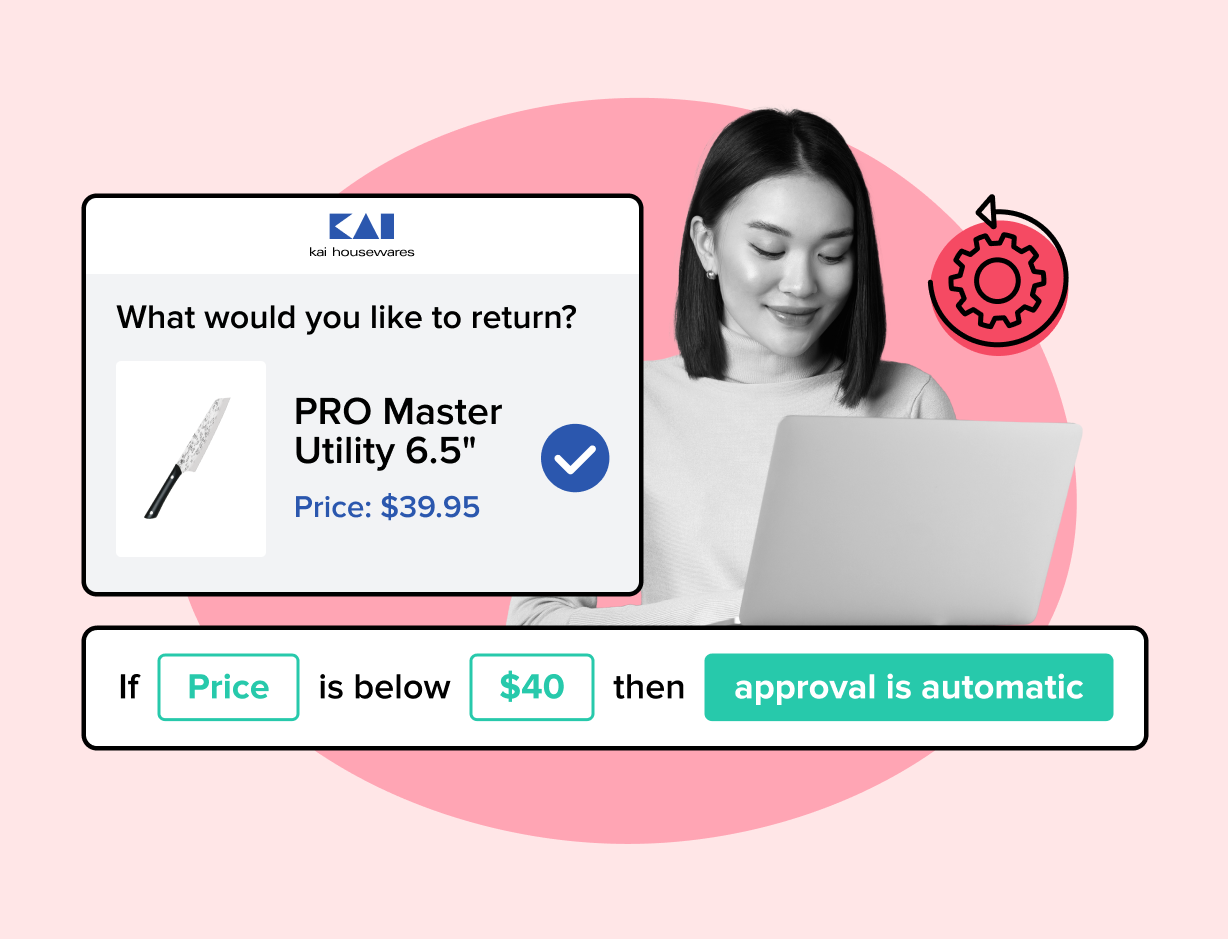
Hassle Free Returns on Shopify or Magento: How to Create a Seamless Experience
Learn how to manage BOGO returns effectively while ensuring customers aren’t charged for the free item. Practical solutions!
Boost customer experience and reduce support tickets
Realtime order and shipment tracking
Proactive order and shipping notifications
Predictive pre-purchase estimated delivery dates
Self-Serivce branded order tracking
Effortless experience delivered
Make returns profitable and delight customers
Flexibility to define any return destinations & conditions
Simplify returns for your customers and team
Incentivize exchanges over returns
Returns management made easy for your team
Understand why your customers are returning
Unify the online and the in-store experience
Hassle-free pickup experience for customers
In-Store Dashboard to keep operations streamlined
In-Store and Online orders unified
Drive foot-traffic to your stores
Boost customer experience and reduce support tickets
Realtime order and shipment tracking
Proactive order and shipping notifications
AI-Enhanced Discounted Labels
Predictive pre-purchase estimated delivery dates
Self-Serivce branded order tracking
Effortless experience delivered
Make returns profitable and delight customers
Flexibility to define any return destinations & conditions
Simplify returns for your customers and team
Incentivize exchanges over returns
Returns management made easy for your team
Equip your team for precise return checks.
Understand why your customers are returning
Unify the online and the in-store experience
Hassle-free pickup experience for customers
In-Store Dashboard to keep operations streamlined
In-Store and Online orders unified
Drive foot-traffic to your stores
Find the answer to all your questions
Explore the most comon questions about WeSupply
Calculate the ROI that WeSupply can bring you
Request a no strings attached review of your current shopping experience and missed conversion opportunities
Take a step by step trip through our functionality to see how we can improve your ecommerce processes.
Read actionable articles on how to optimize your post-purchase experience and decrease support tickets
Get inspired by stories of how our customers implemented an effortless post-purchase experience
A Deep Dive into Top Companies' Order Tracking & Returns Strategy
Wondering if WeSupply is a good fit for you? Read through our use cases to see how we can help you increase conversion & improve CX!

Automated return policies have become a cornerstone of successful ecommerce businesses, directly impacting customer satisfaction and long-term loyalty. By leveraging automation, businesses can transform what was once a cumbersome returns process into a straightforward, customer-friendly experience. Automated return policies allow customers to initiate returns, request exchanges, or opt for store credit with just a few clicks eliminating unnecessary friction and making the process hassle free.
For businesses, automation means more than just efficiency. It provides valuable insights into return patterns, helping identify trends and areas for improvement. With these insights, companies can refine their return policies to better meet customer needs and retain revenue that might otherwise be lost to refunds. Automated systems can also encourage customers to choose exchanges or store credit over a full refund, keeping more revenue within the business and fostering repeat business.
Additionally, automating refunds and exchanges helps reduce the risk of fraudulent returns by flagging suspicious activity and enforcing return rules consistently. By integrating these automated solutions, businesses not only streamline their operations but also provide customers with a reliable, transparent, and positive return journey ultimately enhancing the overall customer experience and building stronger customer relationships.
In e commerce, what happens after the customer clicks “Buy” can make or break their relationship with your brand. Returns aren’t just a cost of doing business they’re a major factor in customer satisfaction, loyalty, and long-term revenue retention. Customer returns can significantly impact business operations, affecting inventory management, financial planning, and customer trust. A well-designed return policy is essential for creating a positive customer experience, ensuring that customers feel confident and supported throughout the process. When done right, returns can be a competitive advantage.
But here’s the challenge: as your business scales, manually handling every return becomes inefficient, error-prone, and costly. That’s where automation comes in. By automating the return process, you can save time and reduce human error. However, there’s a big catch automation shouldn’t strip away the flexibility and personalization that customers expect. Maintaining excellent customer service is crucial, even as you automate, to address customer concerns and build lasting loyalty.
So how do you automate your return policy without losing flexibility? Let’s walk through the process, step by step.
Before you dive into automation, it’s essential to understand your current return landscape. That means auditing every aspect of your return process from customer touchpoints to backend workflows.
But here’s the challenge: as your business scales, handling returns manually becomes inefficient, error-prone, and costly.
Start by analyzing your return rates and identifying the most common return reasons. Are customers sending items back because of sizing issues, shipping damage, or incorrect product descriptions? Understanding this helps you decide which returns can be automated and which require more careful handling.
Next, map out your existing process. Which returns are routine and repeatable (like clothing exchanges for size)? These are perfect candidates for automation. Which ones are more complex or emotionally charged (like damaged goods or high-ticket item returns)? These cases may need a human touch.
This audit doesn’t just guide your automation it helps define clear exception paths for edge cases, ensuring no customer falls through the cracks.
Automation only works if your rules are clearly defined. That starts with a return policy that’s easy to understand and aligned with customer expectations. A clear and comprehensive refund policy is also essential, as it builds customer trust, reduces confusion, and strengthens your overall return strategy.
Make sure your policy outlines key details:
Eligibility: What items can be returned or exchanged?
Timelines: How long do customers have to initiate a return?
Condition Requirements: Must items be unused, unwashed, or with tags?
Return Methods: Can customers return by mail, in-store, or both?
Clarity reduces friction and misunderstandings. Making the fine print of your return and refund policies easy to understand helps build trust with your customers. Be transparent about available resolutions—whether it’s a full refund, exchange, or store credit. And don’t forget to build an accessible FAQ or help page. This proactive approach reduces customer service inquiries and empowers customers to make informed return decisions.
A clear, flexible, and transparent approach leads to a successful return policy that enhances customer satisfaction and loyalty.
To truly automate without losing flexibility, you need the right tools and that starts with a powerful, customizable Returns Management System (RMS). An effective RMS is essential for managing returns efficiently at scale, streamlining the entire process and improving both operational efficiency and customer experience.
Look for a platform that integrates smoothly with your ecommerce stack: Shopify, Magento, WooCommerce, and your inventory, shipping, and payment systems. Integration ensures that data flows seamlessly between platforms, enabling faster processing and fewer manual interventions.
But not all RMS solutions are created equal. Prioritize ones that let you create custom return rules based on:
Product category (e.g., electronics vs. apparel)
Customer history (e.g., VIPs vs. first-time buyers)
Return reason (e.g., damaged vs. changed mind)
Offering multiple return options through your RMS such as omnichannel returns and digital labels can significantly improve customer convenience and satisfaction.
Flexibility in your RMS means you can stay efficient and human adjusting policies dynamically based on the situation.
Integrating your return policies directly with your ecommerce platform is essential for delivering a seamless and satisfying returns experience. When your returns process is connected to platforms like Shopify, Magento, or WooCommerce, you can automate key steps such as matching return requests to orders, triggering refunds, and managing exchanges without manual intervention. This level of integration ensures that customers receive timely updates, can easily track their returns, and experience a smooth, straightforward process from start to finish.
For businesses, ecommerce platform integration drives operational efficiency by reducing manual errors and streamlining workflows. It allows you to handle returns, refunds, and exchanges more quickly, which not only reduces costs but also boosts customer satisfaction and loyalty. Real-time data synchronization means your team can provide customers with accurate information and resolve issues faster, further enhancing the customer experience.
Moreover, integrated systems make it easier to analyze return data, identify trends, and adjust your return policies as needed. By providing customers with a transparent and efficient returns process, you build trust and encourage repeat business turning returns from a pain point into an opportunity for growth and stronger customer relationships.
Customers today expect self-service especially for simple tasks like returns. A self-service return portal is the centerpiece of any automated return system.
A well-designed portal should offer:
Order lookup via email or order number
Return reason selection to gather valuable data
Prepaid return labels generation
Real time tracking of return shipments so customers know what’s happening
Exchange or store credit selection to increase retention
By allowing customers to handle returns on their own terms, you reduce pressure on your support team while improving the overall customer experience. It’s faster, easier, and often more satisfying for everyone involved.
One of the quickest wins in automation is refund processing. Standard returns like “wrong size” or “didn’t like the color” can and should be refunded automatically once the return is initiated or the item is received. Automation enables instant refunds for eligible returns, providing immediate resolution and improving customer satisfaction.
To strike the right balance, set up smart rules:
Automatically issue store credit for eligible returns.
Offer partial refunds when appropriate (e.g., items returned late but still accepted). Refunding strategies can impact both profitability and customer satisfaction, so consider encouraging exchanges over refunds to help preserve revenue.
Flag exceptions like suspected fraud or damaged items for manual review.
This hybrid approach keeps the process fast for the majority of cases while protecting your business from abuse or errors.
Automation isn’t just about efficiency it’s a tool for revenue retention. Rather than defaulting to refunds, use automation to guide customers toward exchanges or store credit. Well-designed exchange policies can improve customer satisfaction while benefiting your business by reducing refund rates and encouraging loyalty.
Let customers swap sizes, colors, or even products directly within the return portal. Incentivize this behavior by offering:
Free shipping for exchanges
Bonus store credit for choosing store credit over refunds
Personalized product suggestions based on their original purchase
These options turn a return into a second chance to delight your customer and keep their money in your ecosystem. Offering incentives, such as discounts or bonus credit, can motivate customers to make their next purchase.
If you have brick-and-mortar locations, let customers return online purchases in-store. It’s convenient, immediate, and can reduce reverse logistics costs.
To make this work:
Train store associates to process returns with your RMS.
Sync inventory systems so returned items can be restocked or routed efficiently.
Offer store credit or exchanges on the spot to encourage in-store purchases.
Provide free return shipping as an added incentive, making returns risk-free and boosting customer satisfaction.
This omnichannel approach adds flexibility for customers while creating opportunities for upselling and engagement.
The secret to automating without losing flexibility is knowing when to let the system take over and when to intervene.
Set rules in your RMS to:
Auto-approve returns that meet predefined criteria
Escalate returns that are suspicious, incomplete, or outside policy
Allow manual overrides by customer service reps for special cases
Automation should empower your team, not replace them. When reps have the tools to make one-time exceptions or offer personalized solutions, you create a more human experience within an automated framework. This approach creates a win-win for both customers and the business, fostering satisfaction and loyalty while protecting business interests.
Automation opens the door to deep insights. Use the data from your RMS to fine-tune your return policy and operations.
Track:
Return rates by product, category, or vendor
Top return reasons
Processing time from initiation to resolution
Customer satisfaction (CSAT) post-return
Disposition of returned merchandise to identify opportunities for restocking, resale, or donation
These metrics tell you what’s working and what’s not. Are certain products returned frequently due to misleading photos? Time to update your listings. Are refund delays creating bad reviews? Time to improve your workflows.
Let the data guide continuous improvement automatically.
Your return policy needs to grow with your business and flex with the calendar. During peak seasons like holidays or promotional events, return volume can surge dramatically.
To handle it:
Focus automation on the 80% of routine cases first
Gradually automate more complex return scenarios as your rules mature
Extend return windows and communicate clearly during holidays
Offer special return options or extended windows for loyal customers
Prepare for higher volumes with support team backup or 3PL partnerships
Scalability means designing a system that performs under pressure without compromising on customer experience.
Returns fraud is a growing concern but cracking down too hard can alienate honest customers. Strike a balance by building fraud prevention into your automation rules.
Best practices include:
Photo uploads to verify damaged or defective items
Return limits for high-frequency returners
Behavior-based rules that flag unusual patterns
An intelligent RMS can use AI and analytics to detect suspicious behavior while still allowing legitimate returns to proceed smoothly. Fraud prevention should be frictionless for good customers but firm for the bad actors. It’s also important to keep customers informed throughout the returns and fraud prevention process, providing timely updates and transparency to build trust and improve the overall experience.
Not every business has the internal resources to handle returns at scale. That’s where outsourcing to a third-party logistics provider (3PL) or reverse logistics specialist comes in.
Benefits of outsourcing include:
Faster processing and faster refunds
Professional handling and repackaging
Streamlined shipping process for returned items, improving tracking, transparency, and customer communication
Seamless return flows for customers
Just make sure your partner supports your policy goals. Choose vendors who can align with your brand tone, offer flexible return conditions, and integrate with your RMS.
Automation shines when your systems work together. A disjointed return process where labels are generated in one system, inventory updated in another, and support tracked elsewhere leads to errors and delays.
Ensure that your systems are integrated:
Order management
Inventory tracking
Shipping and carrier tools
Customer support systems
Returns portal and RMS
A connected ecosystem allows you to automate the entire return journey from label creation to refund and provide real-time updates to customers along the way. This seamless integration helps create a positive shopping experience by ensuring clear communication, easy returns, and increased customer satisfaction.
The best return is the one that never happens. Automation isn’t just reactive it can help you proactively reduce return volume.
Try these proactive tactics:
Improve product images, descriptions, and sizing guides
Add fit prediction tools or AR-powered try-ons
Use post-purchase emails to set expectations and reduce buyer’s remorse
Clearly communicate return policies and provide proactive support to build customer confidence
Collect and act on return reason data to improve listings
By educating and empowering shoppers before they buy, you reduce the likelihood of a return and improve customer satisfaction at the same time. These strategies also enhance the overall customer journey by ensuring transparency and convenience at every touchpoint.
Even the best intentions can lead to return policies that frustrate customers and hurt your bottom line. One of the most common mistakes is creating a return policy that’s too rigid, with strict eligibility criteria or inflexible return rules that discourage customers from making a purchase or returning if needed. This can result in lost sales and damage to your brand’s reputation.
Another pitfall is failing to clearly communicate the return process, refund policies, and any restocking fees. If customers can’t easily find or understand your return policy, they may abandon their purchase or leave negative reviews. Excessive restocking fees or requiring customers to pay for return shipping can also erode customer trust and deter repeat business.
To avoid these issues, ensure your return policy is customer friendly, easy to find, and simple to follow. Provide clear information about eligibility criteria, return rules, and refund options, and make it easy for customers to initiate and track returns. Regularly review and update your return policies to align with your overall customer experience strategy and business goals. By prioritizing transparency and flexibility, you’ll enhance customer trust, encourage more revenue through repeat business, and deliver an excellent customer experience that sets your brand apart.
If you’re wondering how to automate your return policy without losing flexibility, WeSupply offers the perfect solution combining intelligent automation with customizable workflows to create a seamless, customer-first experience that adapts to your brand’s unique needs.
WeSupply empowers ecommerce businesses to handle returns with ease, without sacrificing control or customer satisfaction. Here’s how:
✅ Smart Return Rules – Tailor return conditions to specific item attributes, apply custom logic, and automate approvals based on return reasons, order value, or product category.
✅ Flexible Return Windows – Automatically calculate and apply return windows from the date of delivery, pickup, or even gift receipt eliminating customer confusion and internal guesswork.
✅ Branded, Self-Service Portal – Let customers initiate returns through a fully branded, no-code portal that keeps them engaged and informed with real-time SMS and email updates.
✅ Automatic Return Label Generation – Save time and reduce support tickets by allowing customers to generate return labels instantly even outside business hours.
✅ Partial Refunds & Intelligent Dispositions – Refund items individually, track receipt status, and optimize warehouse processing with clear sorting instructions.
✅ Instant Store Credit & Exchange Incentives – Turn refunds into new sales by offering store credit on the spot and promoting exchanges helping you recapture up to 95% of return-related revenue.
✅ Buy Online, Return In Store – Give customers the flexibility they expect while reducing shipping costs and boosting foot traffic in physical locations.
✅ Fraud Detection & Control – Use return reason logic and customer history to auto-approve low-risk returns while flagging suspicious activity to prevent fraud.
✅ Seamless Integration – WeSupply integrates directly with your ERP, WMS, 3PL, and ecommerce platforms for a truly automated return experience.
✅ Analytics & Insights – Make data-driven decisions with real-time visibility into return rates, top return reasons, CSAT, NPS, and more all accessible in BigQuery.
With WeSupply, automating your return policy doesn’t mean giving up flexibility. It means gaining smarter controls, happier customers, and a returns experience that actually boosts your bottom line. Book a demo today!
Automating your return policy isn’t about losing flexibility it’s about removing friction while gaining control. With WeSupply, you can create smart return rules based on item attributes, automatically generate labels, offer instant store credit, and even promote in-store returns to cut shipping costs and drive foot traffic. A branded, self-service returns portal gives customers a seamless experience, while automated workflows handle approvals, sorting, and partial refunds behind the scenes.
Real-time analytics let you track why returns happen, who’s making them, and how to reduce them while CSAT, NPS, and CES scores help fine-tune the customer journey. Integration with your ERP, WMS, or 3PL ensures everything runs smoothly at scale.
The result? A return experience that’s fast, flexible, and fully aligned with your brand built to delight customers and empower your team. With WeSupply, automation becomes your competitive edge, helping you recover revenue, reduce fraud, and turn every return into an opportunity to build loyalty.
Combat inconvenience with proactivity & self service
Book a quick call with our experts to see how WeSupply can help you make returns easy for your customers with a beautiful, self-service solution that makes their experience easier while also providing new ways to lower costs and earn back revenue.
Keep your customers engaged during the delivery experience
Book a quick call with our experts to see how WeSupply can help you engage your customers with relevant updates through the right channel, at the right time.
1. How do I automate my ecommerce return policy?
Use a Returns Management System (RMS) integrated with your ecommerce platform to automate approvals, refunds, and exchanges while customizing rules for flexibility.
2. What are the benefits of automating returns?
Automating returns reduces manual work, improves customer satisfaction, speeds up processing, prevents fraud, and provides valuable data to refine products and policies.
3. Can automation reduce return fraud?
Yes! Automated systems flag suspicious patterns, enforce return rules consistently, and verify returns with photos or customer history, reducing fraud without hurting honest shoppers.
4. How does WeSupply automate return policies without sacrificing flexibility?
WeSupply uses smart rules, instant store credit, branded portals, and partial refunds to automate returns while giving businesses control and customers choices.
5. Does WeSupply support buy-online-return-in-store?
Yes! WeSupply enables omnichannel returns, letting customers buy online and return in-store. This improves flexibility, saves on shipping costs, and drives in-store sales.
6. Can WeSupply help prevent return fraud?
Absolutely. WeSupply uses automated fraud detection with return reason logic and customer history to auto-approve low-risk returns while flagging suspicious cases.
7. Does WeSupply have an Official Shopify App?
Yes. WeSupply has an Official Shopify App. You can download it and start integrating with your Shopify Store.
8. Does WeSupply have an official Magento extension?
Yes, WeSupply has an official extension for Magento. The WeSupply x Magento integration allows for automating order tracking experiences, reducing customer inquiries, automating shipping email and SMS notifications, and providing a fully branded order tracking experience
9. Does WeSupply have an official BigCommerce App?
Yes, WeSupply has an official BigCommerce App. You can integrate WeSupply with your BigCommerce store to improve your post-purchase customer experience.
Learn How To Create Successful Post Purchase Email Campaigns
Build an effective post-purchase email flow that helps you increase customer satisfaction and drive revenue growth!

Learn how to manage BOGO returns effectively while ensuring customers aren’t charged for the free item. Practical solutions!

Explore how automation and data can enhance your shipping strategy. Discover best practices to stay competitive and efficient. Read the article now!

Discover effective strategies to prevent return promo abuse with smart logic. Enhance your business’s integrity!

Learn how to effectively manage promo bundle returns while protecting your revenue. Discover practical tips to streamline your process!

Learn how to manage BOGO returns effectively while ensuring customers aren’t charged for the free item. Practical solutions!

Explore how automation and data can enhance your shipping strategy. Discover best practices to stay competitive and efficient. Read the article now!

Discover effective strategies to prevent return promo abuse with smart logic. Enhance your business’s integrity!

Learn how to effectively manage promo bundle returns while protecting your revenue. Discover practical tips to streamline your process!

Boost your revenue by turning returns into opportunities with personalized upsell offers. Discover effective strategies!